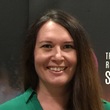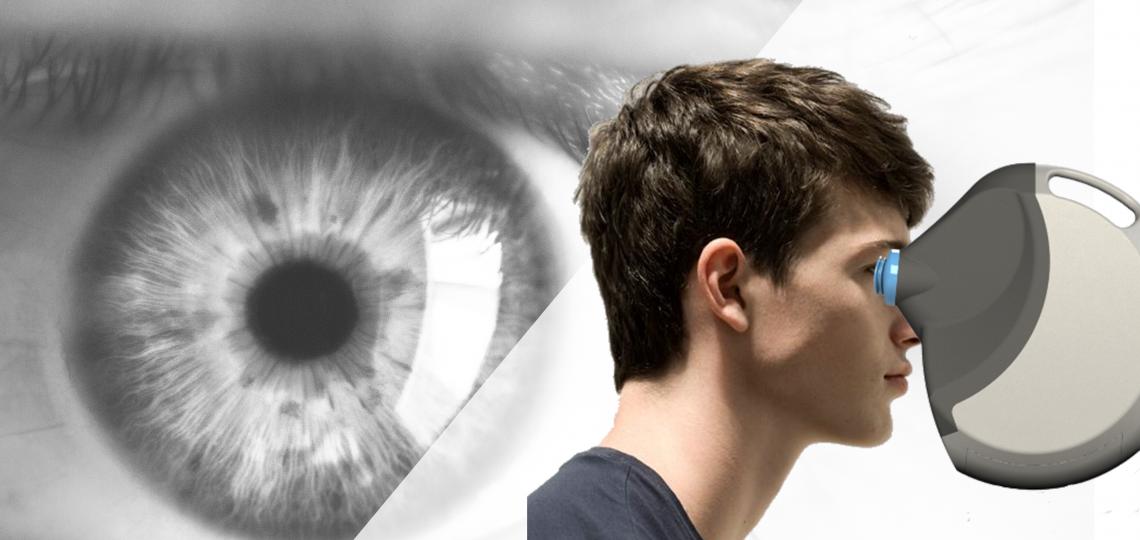Advancing Medical Technology for Space
The Translational Research Institute for Space Health (TRISH) is looking beyond today's marketplace of smartwatches and wearables for innovation at the crossroad of health and technology. We focus on tracking individuals to prevent disease states from developing and putting state-of-the-art tools in their hands to administer health care just in time.
Previously Funded Investigations

Research: Objective refraction with self-operable, lightweight autorefractor
Company: PlenOptika
Start date: May 1, 2019
End date: April 30, 2020
Study type: Ground study
NASA Risk Addressed: Spaceflight Associated Neuro-Ocular Syndrome (SANS)
Project: Over a billion people worldwide suffer from poor vision because they do not have adequate access to eye care professionals who can prescribe affordable eyeglasses. To meet this need, PlenOptika developed QuickSee, a portable, durable, low cost, yet highly accurate binocular autorefractor to quickly measure refractive errors and to monitor changes over time, making effective prescriptions easier to obtain. PlenOptika is planning a lighter model to make QuickSee easier to use for children and elderly patients, and other design advancements for faster and more reliable measurements.
PlenOptika designs innovative technologies to improve vision care globally. Their flagship device the QuickSee™ Wavefront Refractor was born at MIT, incubated at Harvard and Boston University, and raised around the world to meet high standards of vision and health care professionals under both rigorous clinical and demanding global health conditions. QuickSee’s accuracy has been published in peer-reviewed journals, it has earned international recognition and awards, and it is currently in use by private and nonprofit healthcare organizations internationally. www.plenoptika.com

Research: Investigating the Combinatorial Effects of Intraocular Pressure and Hypobaric Hypoxia on Corneal Function
Institution: Tufts University
Start date: Aug. 1, 2019
End date: March 31, 2021
Grant Mechanism: Single PI grant
Study type: Ground study
NASA Risk Addressed: Med Tech / Devices
Project: We are developing a tissue system to gain insights into the pathophysiology of SANS by enabling the study of the simultaneous effects of increased intraocular pressure (IOP) and hypoxia on corneal tissue/cell function. This will facilitate the development of methods to alleviate symptoms associated with space flight and maintain ocular health and vision stability of astronauts. We propose to utilize our established, unique, 3D corneal tissue models, containing a neuronal component, in combination with a custom-built bioreactor and hypoxia chamber to investigate tissue response to both short (days) and long-term (weeks, months) exposure to high IOP and a hypoxic environment in vitro. We hypothesize introduction of elevated IOP and hypoxia will result in increased neuronal sensitization, as well as morphological and organizational changes to the individual cell components and extracellular matrix components within our cornea tissue models.

Research: Miniaturized Diagnostics Platform for Health Assessment in Deep Space
Company: 1Drop Diagnostics
Start date: Sept. 1, 2018
End date: Aug. 31, 2019
Study type: Ground study
NASA Risk Addressed: Medical
Project: Current diagnostic tests used in healthcare settings are typically performed in a centralized laboratory. 1Drop Diagnostics is developing a point-of-care diagnostics device that can perform sensitive, specific, and rapid detection of multiple blood-based biomarkers. The device is small, portable, and easy-to-use allowing astronauts to perform important health assessments during space travel.

Research: The Cytotracker: Point-of-use Complete Blood Count
Company: Rizlab Health Inc.
Start date: May 1, 2019
End date: April 30, 2020
Study type: Ground study
NASA Risk Addressed: Medical
Project: A complete blood count measures the number of different types of cells, such as red blood cells, white blood cells and platelets, in the blood. It is one of the most commonly performed laboratory tests in healthcare to monitor overall well-being and disease status. Current methods to obtain accurate blood counts require venous blood draws by a healthcare professional and utilize several different methods for counting and do not have the form factor necessary for operation by astronauts in space. Rizlab is developing a portable analyzer that combines unique and multiple sensors and methods for testing and provides rapid results that are simpler and less expensive than current testing methods. Their system will use a small amount of blood, which can be obtained from a finger prick, allowing use outside typical healthcare settings. The goal of this project is to build an analyzer that has the form factor and interface suitable for use in a space shuttle and extreme space environment.

Research: Intelligent Assistance for Accurate and Reliable Lymphatic Data Collection
Institution: Institute for Human and Machine Cognition, Pensacola, Fla.
Start Date: March 1, 2019
End Date: March 31, 2020
TRISH Synergy Project: PI Dawn Kernagis
Study Type: Ground Study
NASA Risk Addressed: HSID
Major Aim of Project: To use machine learning techniques to provide user feedback about the usefulness and quality of the data being collected in terms of accurately measuring lymphatic function (PI Dawn Kernagis) in order to improve lymphatic function measurement.

Research: Non-contact sleep, vitals, and behavior sensing
Company: Emerald Innovations Inc.
Start date: May 1, 2019
End date: Sept. 30, 2020
Study type: Ground study
NASA Risk Addressed: Medical
Project: The Emerald device wirelessly analyzes radio signals to evaluate movement, breathing, sleep, and other behavior without the need to wear a device. It has been used in controlled environments such as laboratories and clinics, where the information was shown to be applicable to patient health outcomes. Emerald Innovations proposed to extend use of this device to a person’s natural living environment. To do so, the system must:
- Collect, analyze, and store information continuously and reliably
- Maintain user profiles to monitor change
- Allow access to the stored information in a way that is easy to understand. When presented in a meaningful way, this information can guide user actions to improve health.

Research: Cervical lymphatic function quantification and associated molecular changes in response to simulated microgravity
Institution: Institute for Human and Machine Cognition, Pensacola, Fla.
Start date: Oct. 1, 2017
End date: April 30, 2020
Grant Mechanism: Single PI grants
Study type: Ground study
NASA Risk Addressed: Risk of Spaceflight Associated Neuro-ocular Syndrome (SANS)
Project: Low levels of gravity (zero gravity) has physiological effects on many different systems in astronauts. For example, astronauts exposed to long durations of zero gravity develop visual changes and signs of increased intracranial pressure. Cerebrospinal fluid may drain into the lymphatic system to help regulate cranial pressure; however, zero gravity may affect this drainage. Dr. Kernagis proposed to evaluate a new lymphatic imaging device paired with a diagnostic tool to measure lymphatic function through biomarkers. The aims are to determine if there are problems associated with lymphatic draining in microgravity.

Research: Create a Proof of Concept Device for a Compact Multi-VCSEL SweptSource-OCT Including Associated Signal Analysis Algorithms, andData Review Software for Deep Space Missions
Institution: Kubota Pharmaceuticals
Start Date: March 1, 2019
End Date: Feb. 29, 2020
Study Type: Ground study
NASA Risk Addressed: Spaceflight Associated Neuro-Ocular Syndrome (SANS)
Project: Acucela is developing unique, self-testing, compact, vision diagnostic equipment that can be used in the space program and for in-home monitoring of eye diseases and overall eye-health, providing eye doctors ongoing valuable treatment information while saving astronauts’ time and complexity as well as providing superior care for patients while saving them time and money. Acucela is developing a unique Swept Source OCT (SS-OCT) employing a distinctive light source in combination with proprietary laser technology. A swept source OCT modulates the wavelength of a laser to achieve greater OCT resolution. This device will allow NASA to replace the current off-the-shelf OCT device(s) on the ISS with a more compact, easier to use self-testing device that is radiation hardened and allows lower bandwidth when transmitting health data back to earth. This increases practicality for smaller spacecraft as well and improves image quality received from astronauts in-flight.

Research: Development of a Self-Imaging, Wide Angle, High Resolution Retinal Imaging System for Human Spaceflight Applications
Institution: Web Vision Centers Group, LLC
Start Date: Sept. 1, 2017
End Date: Aug. 31, 2018
Study Type: Ground study
NASA Risk Addressed: Spaceflight Associated Neuro-Ocular Syndrome (SANS)
Project: Web Vision developed a compact, desk mounted, self-imaging, non-mydriatic, 45+ degree wide-angle, high resolution retinal imaging device known as the Advanced Retinal Imager (ARI). The device allows astronauts to self-test, saving time over current technology and without the need to dilate the pupil.
Research: Development of a Goggle-Based Visual Field Device Prototype
Institution: Web Vision Centers Group, LLC
Start Date: April 1, 2018
End Date: March 31, 2020
Study Type: Ground study
NASA Risk Addressed: Spaceflight Associated Neuro-Ocular Syndrome (SANS)
Project: Space travel causes changes in an astronaut’s vision, including changing the shape of the eyes. This project will develop a prototype of a novel, ultra-small visual fields device that will be goggle shaped for the purposes of conducting visual fields (VF) testing of astronauts in-flight. This device (based on NASA’s specifications) is intended to detect, monitor progression, and guide medical intervention of severe SANS cases during long duration space missions.
Research: Create the Technical Requirements, Strategic Roadmap, and Financial Requirements to Develop a Multifunction Ophthalmic Device for Comprehensive Ophthalmic Vision Testing on Deep Space Missions
Institution: Web Vision Centers Group, LLC
Start Date: Aug. 1, 2018
End Date: July 31, 2019
Study Type: Ground study
NASA Risk Addressed: Spaceflight Associated Neuro-Ocular Syndrome (SANS)
Project: Astronauts experience changes in their vision and eyes during space missions. Web Vision has proposed developing a compact, comprehensive Multifunctional Ophthalmic (all-in-one) vision testing Device (MOD) to be used during extended space missions to deliver a comprehensive eye health assessment of the astronauts. This MOD will include vision testing functionalities such as retinal imaging, visual-fields, OCT (Optical Coherence Tomography), and Visual Acuity assessment, all inside of one compact device.
Research: Development of Advanced Vision Testing Software for a Goggle-Based Visual Field Device Prototype
Institution: Web Vision Centers Group, LLC
Start Date: Aug. 1, 2018
End Date: March 31, 2020
Study Type: Ground study
NASA Risk Addressed: Spaceflight Associated Neuro-Ocular Syndrome (SANS)
Project: During space missions, particularly after spending long periods in space, astronauts develop changes in their vision. In a different project, Web Vision is developing a small, portable, hand-held goggle-based device that can perform visual tests and measure vision changes during space travel. This proposal is to develop advanced vision testing capabilities (software) that will be used in that Goggle-Based Visual Fields device. This project will add four additional vision tests to the GBVF device: kinetic papillary detection, panoramic visual field, contrast sensitivity testing, and advanced version of the Ishihara color test.

Research: Autonomous Medical Response Agent (AMRA)
Company: Nahlia
Start date: Sept. 1, 2018
End date: Nov.. 30, 2019
Study type: Ground study
NASA Risk Addressed: Medical
Project: During deep space exploration missions Astronaut crews will not have real-time access to expert physicians. Astronauts will need to diagnose, treat, and manage their own medical issues independently from Earth physicians. When a problem occurs, the Autonomous Medical Response Agent first guides Astronauts through a personalized health history, physical examination, and laboratory assessment. AMRA then recommends the best treatments available on board by combining the unique characteristics of each astronaut with high quality medical evidence. Astronauts will be free to choose which treatment based on their desired outcome. AMRA will guide Astronauts through their chosen treatment, and the measured result is used to guide the next decision. AMRA continues in this way until the Astronaut is healed, or comes home. AMRA is based on internationally utilized medical coding that will allow highly accurate, low-bandwidth communication with mission control and can integrate with earth based EMR's to help Astronauts stay healthy beyond the mission.

Research: Room Temperature Stable Basic Metabolic Panel
Company: Ativa Medical
Start date: May 1, 2019
End date: March 31, 2020
Study type: Ground study
NASA Risk Addressed: Medical
Project: Current methods for basic laboratory blood tests require a trained healthcare professional to draw blood using supplies that need refrigeration or may not have a long shelf-life. Ativa proposed to develop an easy-to-use basic metabolic panel test with 2-year shelf life and no need for refrigeration. Their system uses an electrosensor to analyze a small blood sample taken from a finger or heel prick, thereby eliminating the need for a trained phlebotomist to draw a blood sample. Test results are displayed on a touch-screen interface, both numerically and graphically, allowing non-experts to understand their own diagnostic results.

Research: VisualDx Augmented Intelligence Project
Company: VisualDX
Start date: Sept. 1, 2018
End date: Aug. 31, 2019
Study type: Ground study
NASA Risk Addressed: Medical
Project: Space travel presents unique challenges to healthcare, including the potential need for non-healthcare professionals to provide medical care. VisualDX has combined machine learning with clinical data to allow non-healthcare professionals to diagnose certain conditions. Dr. Papier proposed to expand the VisualDXsystem to include an Android version of the software that does not require internet access to use. This system could be used by astronauts during space travel to diagnose health conditions that may arise.

Research: VisualDx Clinical Decision Support for Ultrasound
Company: VisualDX
Start date: April 1, 2019
End date: March 31, 2020
Study type: Ground study
NASA Risk Addressed: Medical
Project: AI-machine learning image based analysis is poised to transform the interpretation of radiologic, pathologic, ophthalmologic and dermatologic imagery. Comprehensive integration of machine learning image analysis with clinical decision support fills a need in exam rooms around the world. Furthermore, there is tremendous need for health information technology in rural and developing nations with limited network access. There is also limited clinical access to specialists in emerging markets. Our project with NASA will allow standalone access of our product globally thereby addressing these needs.

Research: Translational Research for Autonomous Care Coordination (TRACC)
Institution: Nascent Science & Technology
Start Date: March 1, 2019
End Date: Feb. 29, 2020
TRISH Synergy Project: PI Jayant Menon
Study Type: Ground Study
NASA Risk Addressed: HSID
Major Aim of Project: To provide human factors augmentation for an Autonomous Medical Response Agent (PI Jayant Menon) by assessing consequences that medical conditions have for resilience of exploration capabilities as well as the health hazards imposed by those capabilities.

Research: The Ex-vivo Human Translaminar Autonomous System to Study SANS Pathogenesis
Institution: University of North Texas, Fort Worth, Texas
Start date: June 1, 2019
End date: Aug. 31, 2020
Grant Mechanism: Focused Investigation Project
Study type: Ground study
NASA Risk Addressed: Risk of Spaceflight Associated Neuro-ocular Syndrome (SANS)
Problem Addressed: Astronauts exposed to long-duration missions experience fluid shifting from the legs to the head due to microgravity. Some astronauts will experience intracranial pressure changes, which could impact their vision or cause other negative health effects. This project will use a human ex-vivo model to better understand the 3D element and cell types in the posterior eye cup, creating a retinal and optic nerve scaffold to study SANS.

Research: Establish the feasibility of engineering a human optic-nerve-on-a-chip as an in vitro model for SANS research
Institution: AxoSim, Inc.
Start date: June 1, 2019
End date: May 31, 2020
Grant Mechanism: Focused Investigation Project
Study type: Ground study
NASA Risk Addressed: Risk of Spaceflight Associated Neuro-ocular Syndrome (SANS)
Problem Addressed: Astronauts exposed to long-duration missions experience fluid shifting from the legs to the head due to microgravity. Some astronauts will experience intracranial pressure changes, which could impact their vision or cause other negative health effects. This project will develop inducible pluripotent stem cells to build on optic-nerve-chip to study if this tissue plays a role in SANS.

Research: Design of “Autonomous Medical Response Assistant” Interface Prototype for Long Duration Spaceflight
Institution: NASA Ames Research Center, Mountain View, Calif.
Start Date: March 1, 2019
End Date: Feb. 29, 2020
TRISH Synergy Project: Jayant Menon, M.D.
Study Type: Ground Study
NASA Risk Addressed: HSID
Major Aim of Project: This project aims to develop a user-centered research and design process to define the needs of crewmembers interacting with an “Autonomous Medical Response Assistant (Dr. Menon’s project)” in long duration spaceflight. The human-centered design augmentation research will entail: domain-specific and analogous research in medical care, interaction design of a screen interface, prototype usability testing and evaluation.

Research: InnaMed TeleLab Platform
Company: InnaMed, Inc.
Start date: April 1, 2019
End date: April 30, 2020
Study type: Ground study
NASA Risk Addressed: Medical
Project: InnaMed proposed developing TeleLab®, a smart, portable device that can test small molecule and protein biomarkers using a small (microneedle) amount of blood in the point-of-care or home settings. The platform uses published, patented electrochemical and DNA-based technologies to remotely monitor conditions such as heart failure and organ transplants and delivers cloud-based results to clinicians for therapy adjustment. This technology allows follow-up testing in a patient’s home rather than at a clinic visit, saving time and cost while improving the monitoring of chronic diseases.

Research: Label-free photoacoustic lymphatic flowgraphy in simulated microgravity
Institution: California Institute of Technology, Pasadena, Calif.
Start date: Oct. 1, 2017
End date: Sept. 30, 2019
Grant Mechanism: Single PI grant
Study type: Ground study
NASA Risk Addressed: Risk of Spaceflight Associated Neuro-ocular Syndrome (SANS)
Project: Exposure to zero gravity causes physiological changes in astronauts, including eye and vision changes theorized to be caused by head-ward shift of bodily fluids. Of the body fluids that shift in the head, lymphatic fluid is difficult to image and measure typically requiring the use of contrast dyes, which must be administered in a typical healthcare setting. However, this is not feasible for space travel. Dr. Wang proposed to develop a system to image lymphatic flow without dyes, using photoacoustic imaging, which could be used during space travel. This system would allow monitoring of astronauts’ lymphatic fluid flow during space travel to determine its effects on astronauts’ eyes and vision.

Research: Conversational Intelligent Agents For Astronaut Behavioral Health and Performance
Institution: Ejenta
Project dates: Nov. 1, 2020 – Dec. 31, 2021
NASA Risk Addressed: Risk of adverse cognitive or behavioral conditions (BMed)
Project: Ejenta will develop a conversational intelligent agent to support the health and performance of crew members during long duration and exploration spaceflight. The intelligent agent facilitates communication, collaboration and connection with an astronaut's Earth-based support network, despite time delays, and it acts as a proxy when real-time monitoring and advising is not available from Earth.

Research: Mixed Reality (MR) Care-Delivery Guidance System to Support Medical Event Management on Long Duration Exploration Missions
Institution: Brigham and Women's Hospital, Boston, Mass.
Project dates: April 1, 2020 – March 31, 2022
NASA Risk Addressed: Risk of adverse health outcomes and decrements in performance due to inflight medical conditions (Medical)
Project: The research team is utilizing existing technology to develop MR software that provides realistic training scenarios for astronauts and combine medical education with real-time clinical support for some probable medical events in deep space. This includes a “SMART checklist” which guides astronauts through managing medical events in real-time. MR allows us to create lifelike space environments for astronauts to practice their skills. When complete, the product and guidance can be incorporated into astronaut training to ensure that they have the knowledge, skills, and support to manage the expected and unexpected challenges on deep space missions.

Research: Actionable Deep Space Stroke Detection with Deep Learning and Retinal Imaging
Institution: The University of Texas Health Science Center at Houston, Texas
Project dates: April 1, 2020 – March 31, 2022
NASA Risk Addressed: Risk of adverse health outcomes and decrements in performance due to inflight medical conditions (Medical)
Project: An untreated stroke event would be destructive for a human deep space exploration mission. Increased cerebrovascular disease risk has been documented after prolonged exposures to ionizing radiations on Earth. Astronauts on deep space exploration missions will be exposed to galactic cosmic rays and solar particles for 30 months, which will lead to accelerated vascular injury and a likely increase in stroke risk. In the absence of brain-imaging capabilities in space to permit identification of a stroke, the research team proposes a combination of color fundus photos and Optical Coherence Tomography Angiography (OCT-A) images to identify stroke events and stroke type, effectively acting as a proxy for brain imaging. These imaging modalities are non-invasive and deployable in currently existing technologies for deep space missions. In addition, the team will adapt an automated interpretable image-based deep learning algorithm to identify stroke and stroke type from retinal vascular images, enabling an automated life-saving tool usable on a deep space exploration mission.

Research: Oculometric Cognition Testing and Analysis in Virtual Environments (OCTAVE)
Institution: Z3VR
Project dates: Nov. 1, 2020 – Dec. 31, 2021
NASA Risk Addressed: Risk of adverse cognitive or behavioral conditions (BMed)
Project: OCTAVE will merge the Comprehensive Oculomotor Behavioral Response Assessment system with an enhanced XR system to deliver oculometric measures of human health and performance that could enable future research into neurocognitive, ophthalmological, and psychological stressors of spaceflight conditions with the necessary spatio-temporal fidelity, yet could be implemented operationally.

Research: Multipurpose ultra-portable ultrasound imager with artificial intelligence (AI) capability
Institution: KBR, Houston, Texas
Project dates: June 1, 2018 – Sept. 30, 2022
NASA Risk Addressed: Risk of adverse health outcomes and decrements in performance due to inflight medical conditions (Medical)
Project: The goal of this project is to conduct ground-based and International Space Station (ISS) in-flight evaluation of new solid state ultrasound transducer technology with integrated artificial intelligence (AI) solutions in order to validate their operational usability in continuous microgravity and their innovation potential for operational medical support across all phases of ISS missions. This technology has high potential for valuable contributions to human health and performance capability maturation, in alignment with NASA’s capability-based development goals.








 Credit
Credit
